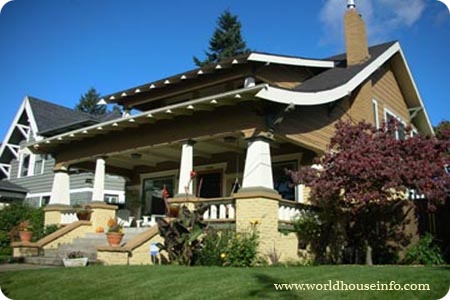Home > Famous Houses in united states > American Bungalow
American Bungalow

The American Craftsman Bungalow: A Testament to Craftsmanship and Simplicity
Introduction:
The American Craftsman bungalow, also known as the Arts and Crafts bungalow, is a distinct architectural style that emerged in the late 19th and early 20th centuries. It represents a departure from the ornate and elaborate Victorian-era designs, instead emphasizing craftsmanship, simplicity, and a close connection to nature. In this essay, we will explore the history, characteristics, and enduring appeal of the American Craftsman bungalow. We will examine how this architectural style encapsulates the ideals of the Arts and Crafts movement and continues to resonate with homeowners and enthusiasts today.
Historical Background:
The American Craftsman bungalow originated in the United States as a response to the industrialization and mass production that characterized the late 19th century. It was part of the broader Arts and Crafts movement, which sought to reclaim the value of handmade craftsmanship and celebrate the beauty of nature. The architectural style gained popularity between the late 19th century and the early 20th century, particularly during the early years of the 20th century.
Characteristics of the American Craftsman Bungalow:
The American Craftsman bungalow is characterized by its distinctive features and design principles, which reflect the ideals of the Arts and Crafts movement. Some key characteristics include:
a. Low-Pitched Roofs: Craftsman bungalows typically have low-pitched roofs with wide, overhanging eaves. The roofs often feature exposed rafters or decorative brackets, adding visual interest.
b. Front Porches: Craftsman bungalows often feature inviting front porches with sturdy columns or piers supporting the overhang. These porches serve as spaces for relaxation, socialization, and a connection to the outdoors.
c. Exposed Structural Elements: The bungalow's structure and craftsmanship are celebrated through the exposure of beams, rafters, and other structural elements. This showcases the handmade nature of the construction and adds a sense of authenticity.
d. Natural Materials: Craftsman bungalows prioritize the use of natural materials, such as wood, stone, and brick. These materials are often left in their natural state or finished in earthy tones to harmonize with the surrounding environment.
e. Open Floor Plans: Craftsman bungalows typically feature open floor plans that promote a sense of flow and interconnectedness between rooms. The emphasis is on functional and flexible living spaces.
f. Built-in Cabinetry and Woodwork: Craftsman bungalows often include built-in cabinetry, bookshelves, and other woodwork features. These elements showcase the craftsmanship and provide practical storage solutions.
Influence and Legacy:
The American Craftsman bungalow had a significant influence on residential architecture in the United States. It represented a departure from the formal and ornate Victorian-era designs, instead embracing a more casual and organic approach. The bungalow's emphasis on craftsmanship, simplicity, and a connection to nature resonated with many homeowners seeking a more comfortable and intimate living environment.
The legacy of the American Craftsman bungalow can be seen in the continued popularity of the style today. Many homeowners appreciate the timeless charm and character of Craftsman bungalows, valuing their architectural integrity, attention to detail, and warm, inviting ambiance. The enduring appeal of the bungalow has led to the preservation and restoration of many original examples, as well as the construction of new homes inspired by the style.
Contemporary Interpretations:
While the original Craftsman bungalows were predominantly built in the early 20th century, the style continues to evolve and find relevance in modern times. Contemporary interpretations of the American Craftsman bungalow blend traditional design elements with modern amenities and sustainable features. This allows homeowners to enjoy the nostalgic charm of the bungalow while embracing contemporary lifestyles and environmental consciousness.
Conclusion:
The American Craftsman bungalow stands as a testament to the ideals of the Arts and Crafts movement, celebrating craftsmanship, simplicity, and a connection to nature. Its distinctive architectural features and design principles continue to captivate homeowners and enthusiasts, offering a sense of warmth, authenticity, and timeless beauty. As a cherished architectural style, the Craftsman bungalow represents a historical and cultural touchstone in American residential architecture, reminding us of the enduring value of skilled craftsmanship and the desire for a harmonious relationship with our surroundings.